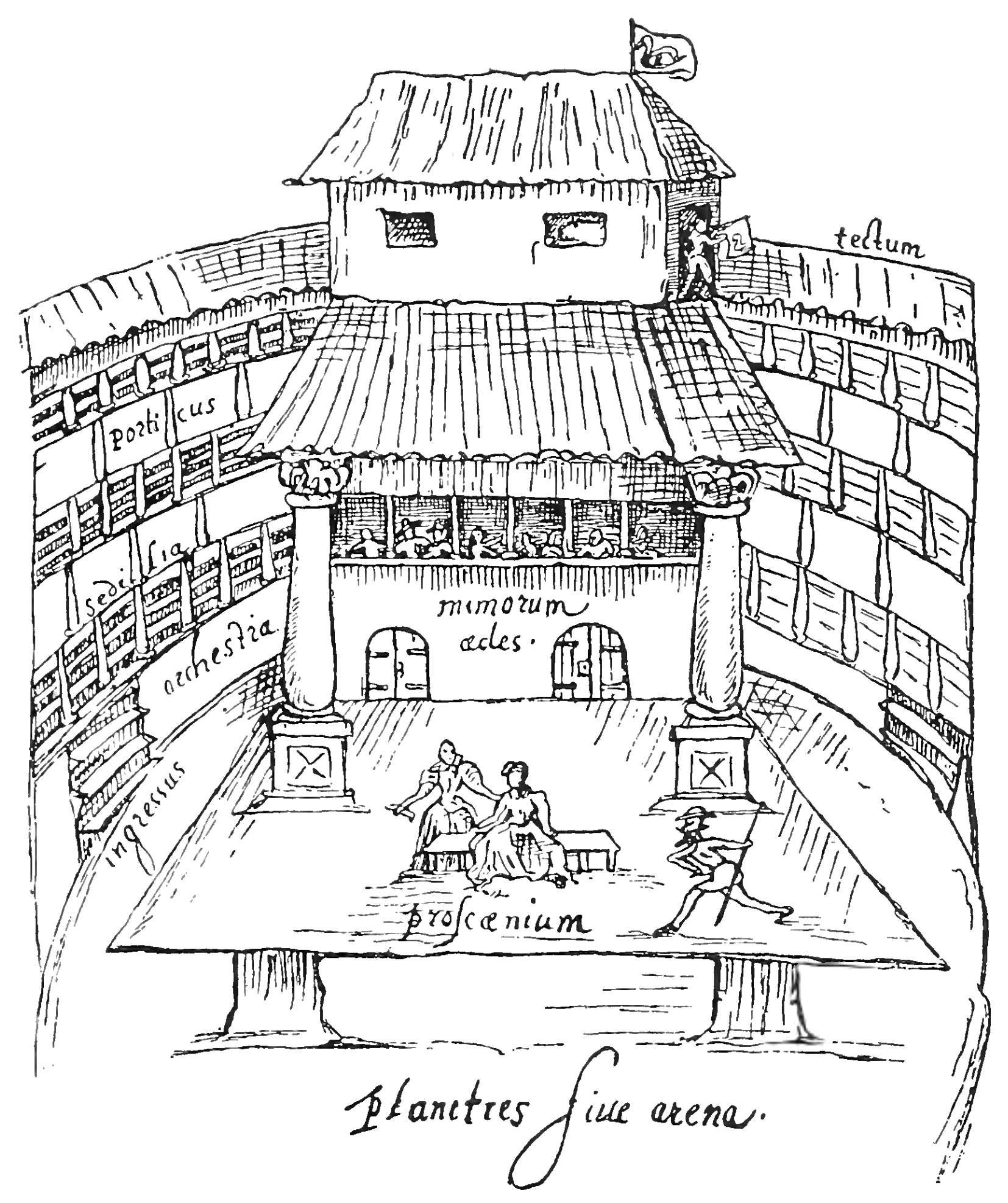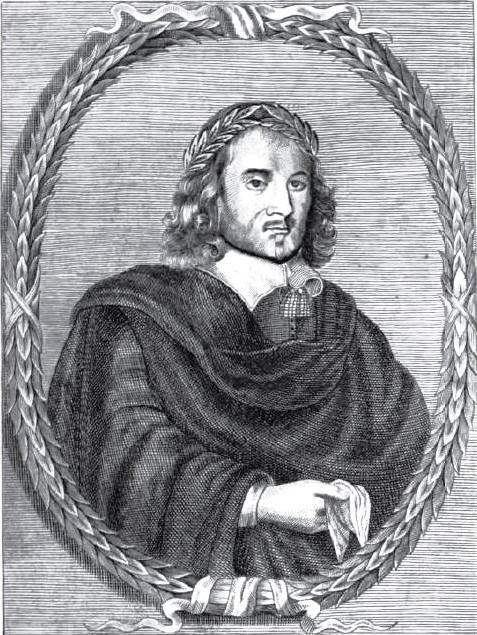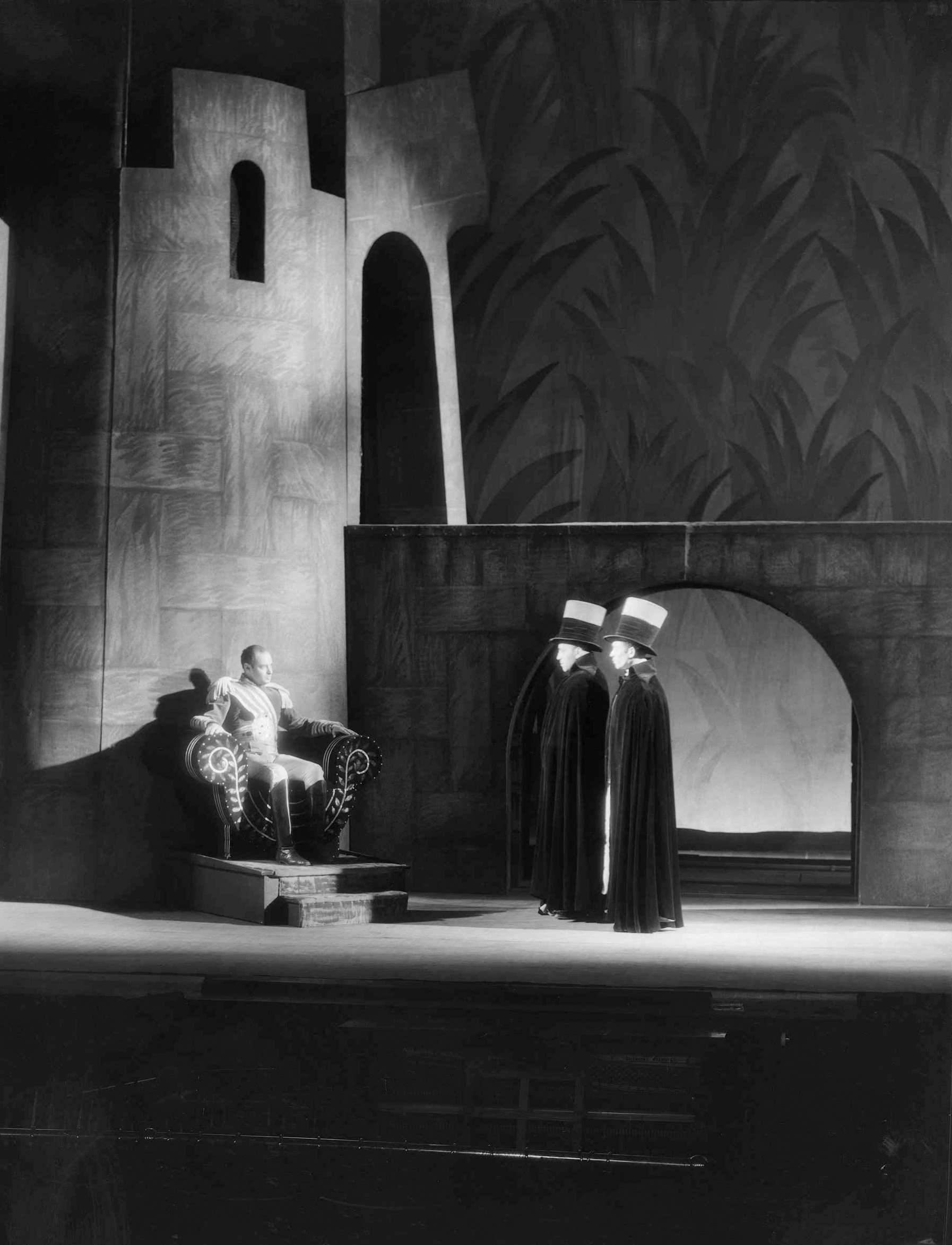|
Law Of Reentry
The law of reentry, sometimes called the principle of the open stage, is a traditional rule in English Renaissance theatre where a character who exits the stage at the end of a scene cannot immediately reenter at the beginning of the next if it is set in a different location. Before the character may reenter, a conversation, speech, or other dramatic action must first take place to clarify that some amount of time has passed and prevent confusion. The law of reentry has been used to explain the numerous scenes in Shakespeare's plays that begin or end with a monologue and the inclusion of speeches and scenes that were "otherwise unnecessary". Other scholars point to examples of a character immediately reentering with others or through another door as adequately illustrating that time has passed or the location has changed between scenes. The law is also described as a convention in public theatre houses, which did not have intermissions between acts, and not in private ones, which ha ... [...More Info...] [...Related Items...] OR: [Wikipedia] [Google] [Baidu] |
English Renaissance Theatre
The English Renaissance theatre or Elizabethan theatre was the theatre of England from 1558 to 1642. Its most prominent playwrights were William Shakespeare, Christopher Marlowe and Ben Jonson. Background The term ''English Renaissance theatre'' encompasses the period between 1562—following a performance of ''Gorboduc'', the first English play using blank verse, at the Inner Temple during the Christmas season of 1561—and the ban on theatrical plays enacted by the English Parliament in 1642. In a strict sense "Elizabethan" only refers to the period of Queen Elizabeth's reign (1558–1603). ''English Renaissance theatre'' may be said to encompass ''Elizabethan theatre'' from 1562 to 1603, '' Jacobean theatre'' from 1603 to 1625, and '' Caroline theatre'' from 1625 to 1642. Along with the economics of the profession, the character of the drama changed towards the end of the period. Under Elizabeth, the drama was a unified expression as far as social class was concerned: th ... [...More Info...] [...Related Items...] OR: [Wikipedia] [Google] [Baidu] |
Christopher Sly
Christopher Sly is a minor character in William Shakespeare's ''The Taming of the Shrew.'' He is a drunk man who is easily dominated by women, set up as a foil to Petruchio, the central male character in the play. Role ''The Taming of the Shrew'' is a play within a play. The frame play, where the action opens (called the " Induction," just prior to Act One), shows a drunk Christopher Sly being ejected from a bar by its hostess. A wealthy lord arrives, finds Sly in a drunken stupor, and decides to play a prank on him. With Sly asleep in his intoxication, the lord's men dress Sly in fine apparel and the men in turn dress up as servants and one even as Sly's wife, in an effort to persuade Sly when he wakes up that he is an aristocrat. After this task is accomplished, the lord's men perform what we know as ''The Taming of the Shrew''. He briefly is seen again making a comment about having some privacy with his "wife" (actually a pageboy in drag). In the standard version of the pla ... [...More Info...] [...Related Items...] OR: [Wikipedia] [Google] [Baidu] |
The English Traveller
''The English Traveller'' is a seventeenth-century tragicomedy in five acts written by Thomas Heywood, and named as such by the playwright. The play was first performed around the year 1627, and the first printed edition came out in 1633. Consisting of two mostly self-contained, but thematically connected plots, one tragic and one comic, it trafficks in the elements of both city comedy and domestic tragedy. In the tragic plot, the recently returned traveler Young Geraldine contemplates forbidden love with the wife of his father's friend Wincott. In the comic plot, the rascal servant Reignald attempts an elaborate cover-up for Young Lionell's drunken party once his father returns from his mercantile voyages. Critics have recognized this as an important work of drama for its generic experimentation, for its investigation of the relationship between appearances and reality, and for its commentary on Renaissance households. Performance and publication The play was first performed b ... [...More Info...] [...Related Items...] OR: [Wikipedia] [Google] [Baidu] |
William Rowley
William Rowley (c. 1585 – February 1626) was an English Jacobean dramatist, best known for works written in collaboration with more successful writers. His date of birth is estimated to have been c. 1585; he was buried on 11 February 1626 in the graveyard of St James's, Clerkenwell in north London. (An unambiguous record of Rowley's death was discovered in 1928, but some authorities persist in listing his year of death as 1642.) Life and work Rowley was an actor-playwright who specialised in playing clown characters (that is, characters whose function is to provide low comedy). He must also have been a large man, since his forte lay specifically in fat-clown roles. He played the Fat Bishop in Thomas Middleton's '' A Game at Chess'', and Plumporridge in the same author's ''Inner Temple Masque''. He also wrote fat-clown parts for himself to play: Jaques in ''All's Lost by Lust'' (a role "personated by the Poet", the 1633 quarto states), and Bustopha in ''The Maid in the Mill' ... [...More Info...] [...Related Items...] OR: [Wikipedia] [Google] [Baidu] |
Thomas Middleton
Thomas Middleton (baptised 18 April 1580 – July 1627; also spelt ''Midleton'') was an English Jacobean playwright and poet. He, with John Fletcher and Ben Jonson, was among the most successful and prolific of playwrights at work in the Jacobean period, and among the few to gain equal success in comedy and tragedy. He was also a prolific writer of masques and pageants. Life Middleton was born in London and baptised on 18 April 1580. He was the son of a bricklayer, who had raised himself to the status of a gentleman and owned property adjoining the Curtain Theatre in Shoreditch. Middleton was five when his father died and his mother's subsequent remarriage dissolved into a 15-year battle over the inheritance of Thomas and his younger sister – an experience that informed him about the legal system and may have incited his repeated satire against the legal profession. Middleton attended The Queen's College, Oxford, matriculating in 1598, but he did not graduate. Before h ... [...More Info...] [...Related Items...] OR: [Wikipedia] [Google] [Baidu] |
The Changeling (play)
''The Changeling'' is a Jacobean tragedy written by Thomas Middleton and William Rowley. Widely regarded as being among the best tragedies of the English Renaissance, the play has accumulated a large amount of critical commentary. The play was licensed for performance by Sir Henry Herbert, the Master of the Revels, on 7 May 1622, and was first published in 1652 by the bookseller Humphrey Moseley. Authorship The title page of the first edition of ''The Changeling'' attributes the play to Middleton and Rowley. The division of authorship between the two writers was first delineated by Pauline Wiggin in 1897, and is widely accepted. David Lake, in his survey of authorship problems in the Middleton canon, summarises the standard division of shares this way: : Middleton – Act II; Act III, scenes i, ii, and iv; Act IV, scenes i and ii; Act V, scenes i and ii; : Rowley – Act I; Act III, scene iii; Act IV, scene iii; Act V, scene iii. Lake differs from previous commentators only ... [...More Info...] [...Related Items...] OR: [Wikipedia] [Google] [Baidu] |
Thomas Heywood
Thomas Heywood (early 1570s – 16 August 1641) was an English playwright, actor, and author. His main contributions were to late Elizabethan and early Jacobean theatre. He is best known for his masterpiece ''A Woman Killed with Kindness'', a domestic tragedy, which was first performed in 1603 at the Rose Theatre by the Worcester's Men company. He was a prolific writer, claiming to have had "an entire hand or at least a maine finger in two hundred and twenty plays", although only a fraction of his work has survived. Early years Few details of Heywood's life have been documented with certainty. Most references indicate that the county of his birth was most likely Lincolnshire, while the year has been variously given as 1570, 1573, 1574 and 1575. It has been speculated that his father was a country parson and that he was related to the half-century-earlier dramatist John Heywood, whose death year is, again, uncertain, but indicated as having occurred not earlier than 1575 a ... [...More Info...] [...Related Items...] OR: [Wikipedia] [Google] [Baidu] |
The Brazen Age
''The'' is a grammatical article in English, denoting nouns that are already or about to be mentioned, under discussion, implied or otherwise presumed familiar to listeners, readers, or speakers. It is the definite article in English. ''The'' is the most frequently used word in the English language; studies and analyses of texts have found it to account for seven percent of all printed English-language words. It is derived from gendered articles in Old English which combined in Middle English and now has a single form used with nouns of any gender. The word can be used with both singular and plural nouns, and with a noun that starts with any letter. This is different from many other languages, which have different forms of the definite article for different genders or numbers. Pronunciation In most dialects, "the" is pronounced as (with the voiced dental fricative followed by a schwa) when followed by a consonant sound, and as (homophone of the archaic pronoun ''thee' ... [...More Info...] [...Related Items...] OR: [Wikipedia] [Google] [Baidu] |
Hamlet
''The Tragedy of Hamlet, Prince of Denmark'', often shortened to ''Hamlet'' (), is a Shakespearean tragedy, tragedy written by William Shakespeare sometime between 1599 and 1601. It is Shakespeare's longest play. Set in Denmark, the play (theatre), play depicts Prince Hamlet and his attempts to exact revenge against his uncle, King Claudius, Claudius, who has murdered Ghost (Hamlet), Hamlet's father in order to seize his throne and marry Gertrude (Hamlet), Hamlet's mother. ''Hamlet'' is considered among the "most powerful and influential tragedies in the English language", with a story capable of "seemingly endless retelling and adaptation by others." It is widely considered one of the greatest plays of all time. Three different early versions of the play are extant: the Hamlet Q1, First Quarto (Q1, 1603); the Second Quarto (Q2, 1604); and the First Folio (F1, 1623). Each version includes lines and passages missing from the others. Many works have been pointed to as possible s ... [...More Info...] [...Related Items...] OR: [Wikipedia] [Google] [Baidu] |
Romeo And Juliet
''The Tragedy of Romeo and Juliet'', often shortened to ''Romeo and Juliet'', is a Shakespearean tragedy, tragedy written by William Shakespeare about the romance between two young Italians from feuding families. It was among Shakespeare's most popular plays during his lifetime and, along with ''Hamlet'', is one of his most frequently performed. Today, the Title character, title characters are regarded as Archetype, archetypal young lovers. ''Romeo and Juliet'' belongs to a tradition of tragic Romance (love), romances stretching back to Ancient history, antiquity. The plot is based on an Italian tale written by Matteo Bandello, translated into verse as ''The Tragical History of Romeus and Juliet'' by Arthur Brooke (poet), Arthur Brooke in 1562, and retold in prose in ''Palace of Pleasure'' by William Painter (author), William Painter in 1567. Shakespeare borrowed heavily from both but expanded the plot by developing a number of supporting characters, in particular Mercutio a ... [...More Info...] [...Related Items...] OR: [Wikipedia] [Google] [Baidu] |
Third Murderer
The Third Murderer is a character in William Shakespeare's tragedy ''Macbeth'' (1606). He appears in one scene (3.3), joining the First and Second Murderers to assassinate Banquo and Fleance, at the orders of Macbeth. The Third Murderer is not present when Macbeth speaks to the First and Second Murderers, and is not expected by his partners. Although the Third Murderer is a small role, the identity of the character has been the subject of scholarly debate, and various productions have equated him with other characters. Role in the play The first two murderers are recruited by Macbeth in 3.1. In 3.3, the Three Murderers meet in a park outside of the palace, and the first two do not know the Third: :''First Murderer''. But who did bid thee join with us? :''Third Murderer''. Macbeth. :''Second Murderer''. He needs not our mistrust, since he delivers :Our offices and what we have to do :To the direction just. The Third Murderer knows Banquo typically walks from the palace gate at ... [...More Info...] [...Related Items...] OR: [Wikipedia] [Google] [Baidu] |
Macbeth (character)
Lord Macbeth, the Thane of Glamis and quickly the Thane of Cawdor, is the title character and main protagonist in William Shakespeare's ''Macbeth'' (c. 1603–1607). The character is loosely based on the historical king Macbeth of Scotland and is derived largely from the account in ''Holinshed's Chronicles'' (1577), a compilation of British history. A Scottish noble and an initially valiant military man, Macbeth, after a supernatural prophecy and the urging of his wife, Lady Macbeth, commits regicide, usurping the kingship of Scotland. He thereafter lives in anxiety and fear, unable to rest or to trust his nobles. He leads a reign of terror until defeated by his former ally Macduff. The throne is then restored to the rightful heir, the murdered King Duncan's son, Malcolm. Origin Shakespeare's version of Macbeth is based upon Macbeth of Scotland, as found in the narratives of the Kings Duff and Duncan in ''Holinshed's Chronicles'' (1587). In the play The tragedy begin ... [...More Info...] [...Related Items...] OR: [Wikipedia] [Google] [Baidu] |




